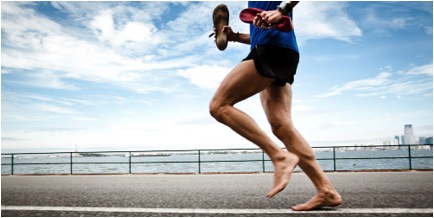
The history of running is a long one, with thousands of champions and too many records broken to even count. Champions like Zola Budd, the former female world record holder in the 5,000 meter and Tegla Loroupe, the two time winner of the prestigious New York Marathon, are often remembered before many of their peers; why is this? They competed barefoot. Budd pounded her bare feet on the track as Loroupe similarly trudged barefoot through New York City, both to be crowned champions.
Although barefoot running is meant to provide beneficial adaptations concerning running and injury prevention, it is inconclusive whether or not it can be used as a sustainable form of training for distance runners in America; thus, if anything it must be approached as preemptive method of injury prevention that is prescribed on a case to case basis.
Research shows the following 6 facts that shed light on barefoot running and injury prevention.
- Heel striking, or rear foot striking, absorbs shock less effectively mainly because of the rigid form the leg takes as it is contacting the ground. This results in a higher rate of loading experienced by the leg.
- Running shoes create a lessened amount of shock absorbed into the lower extremities during impact in heel strikers. Although this is true for a rear foot strike pattern, barefoot running has been found to be more effective in reducing the impact experience in forefoot strikers.
- Wearing shoes can create biomechanical adaptations, such as heel striking, that might cause or lead to injury in runners.
- It has been indicated that the foot striking pattern in a runner is more a critical factor in running-related injury prevention than wearing shoes or running barefoot.
- Barefoot enthusiasts and those considering barefoot running should not simply assume that switching to barefoot running will prevent injuries from happening. Many injuries, such as metatarsal stress fractures, have been documented in runners who have adopted barefoot running.
- Programs that use barefoot running as a supplemental training tool have been successful in creating supposed positive adaptations in runners.
So, can barefoot running prevent injury?
An initial scan of the research done on barefoot running can be overwhelming. Although literature is abundant, studies are often contradictory. There does not seem to be a complete or unified understanding of how barefoot running affects the feet and lower extremities, what biomechanical implications it has for runners’ gaits, and what implications it has on injury prevention in runners. With this being said, there are clearly adaptations that associate with barefoot running. The key to understanding what role barefoot running plays in relationship to injury in runners is understanding what adaptations help prevent injuries. Studies that show that barefoot running creates adaptations offer good insight on how it can affect biomechanics in runners but are not helpful in determining if barefoot running can actually be used as a sustainable method of training or injury prevention. Future research should focus on identifying and understanding features of a runner’s biomechanics that help prevent injury. If these attributes can be identified then a clearer picture of whether barefoot running can be used for injury prevention will be available.
About Tobin
Tobin Villalva’s passion is for athletics and specifically running. He competed for Cal Poly in Cross Country and Track & Field for four years. Currently a Track & Field Coach at Old Mission School in San Luis Obispo, Tobin has worked at GH Sports since 2012. He earned a Bachelors of Science degree in Kinesiology from Cal Poly State University, San Luis Obispo. He is now pursuing a Masters of Science degree in Kinesiology from Cal Poly.
Leave a Reply